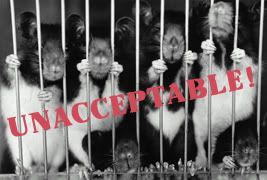Monday, December 18, 2006
Vivisection Facts
"The philosophy behind vivisection, the sacrifice of creatures we regard as 'inferior' beings, differs little from that behind the concentration camp or the slave trader." Aga Khan (Prince Sadruddin) - 1933
A number count
As most governements do not require a complete figure of all animals used in experiments there is no exact number of animals used in experiments. Estimates variate from 20 to 70 million.
These are the numbers for the animals that where counted:
warm-blooded vertebrate animals used in science a year in the US is 28 million (where 18 million are killed for research).
In Canada this is 1.66 million, in the Netherlands 0.73 million.
The vast majority of the animals used (around 90%) are rats and mice specifically bred for the purpose of laboratory research.
Because rodents are not protected under current provisions of the Animal Welfare Act, specific accounting of the numbers that are used are not required by law. As a result, there is no way to know conclusively just how many millions suffer and die each year in publicly and privately funded research. Long ago, rodents became favored "laboratory" animals, not because there were compelling scientific reasons to do so, but rather for reasons of space, economy and convenience. Rodents are small animals, and more of them can be housed in a laboratory than larger animals, such as cats, dogs or monkeys. They also breed faster, and are less expensive to purchase and maintain.
About Vivisecton
Vivisection is the practice of cutting into or using invasive techniques on live animals.
The term is derived from the Latin word vivus, which means alive.
Vivisection is commonly called animal experimentation and includes the use of animals for research, product testing and in education.
Animal testing is the process in which animals are used to test the safety of cosmetics, personal care and household products.
In this form of testing, animals are forced to ingest harmful substances, or have those substances placed on their exposed skin or in their eyes.
Animal testing is conducted by companies (and by laboratories hired by those companies) on both ingredients and final products.
Alternatives to vivisection
Because of advancements in modern technology, there are safe and reliable (often more reliable, quicker and cost-effective) methods of testing products that do not need to experiment on animals while assuring the safety and well-being of the public.
Examples of alternatives are computer and mathematical models to the use of human volunteers. In vitro tests include ones that use cell or tissue cultures, such as artificial test skin derived from human foreskin. Chemical tests include the Neutral Red Bioassay that uses a neutral red, water-soluble dye that is added to normal skin cells in a tissue culture plate, and a computer measurement of the level of uptake of the dye by the cells is used to indicate the relative toxicity.
For further research please visit these sites:
http://www.navs.org/site/PageServer?pagename=index (National Anti-Vivisection Society)
http://www.aavs.org/home.html (American Anti-Vivisection Society)
http://www.neavs.org/ (New England Anti-Vivisection Society)


A number count
As most governements do not require a complete figure of all animals used in experiments there is no exact number of animals used in experiments. Estimates variate from 20 to 70 million.
These are the numbers for the animals that where counted:
warm-blooded vertebrate animals used in science a year in the US is 28 million (where 18 million are killed for research).
In Canada this is 1.66 million, in the Netherlands 0.73 million.
The vast majority of the animals used (around 90%) are rats and mice specifically bred for the purpose of laboratory research.
Because rodents are not protected under current provisions of the Animal Welfare Act, specific accounting of the numbers that are used are not required by law. As a result, there is no way to know conclusively just how many millions suffer and die each year in publicly and privately funded research. Long ago, rodents became favored "laboratory" animals, not because there were compelling scientific reasons to do so, but rather for reasons of space, economy and convenience. Rodents are small animals, and more of them can be housed in a laboratory than larger animals, such as cats, dogs or monkeys. They also breed faster, and are less expensive to purchase and maintain.
About Vivisecton
Vivisection is the practice of cutting into or using invasive techniques on live animals.
The term is derived from the Latin word vivus, which means alive.
Vivisection is commonly called animal experimentation and includes the use of animals for research, product testing and in education.
Animal testing is the process in which animals are used to test the safety of cosmetics, personal care and household products.
In this form of testing, animals are forced to ingest harmful substances, or have those substances placed on their exposed skin or in their eyes.
Animal testing is conducted by companies (and by laboratories hired by those companies) on both ingredients and final products.
Alternatives to vivisection
Because of advancements in modern technology, there are safe and reliable (often more reliable, quicker and cost-effective) methods of testing products that do not need to experiment on animals while assuring the safety and well-being of the public.
Examples of alternatives are computer and mathematical models to the use of human volunteers. In vitro tests include ones that use cell or tissue cultures, such as artificial test skin derived from human foreskin. Chemical tests include the Neutral Red Bioassay that uses a neutral red, water-soluble dye that is added to normal skin cells in a tissue culture plate, and a computer measurement of the level of uptake of the dye by the cells is used to indicate the relative toxicity.
For further research please visit these sites:
http://www.navs.org/site/PageServer?pagename=index (National Anti-Vivisection Society)
http://www.aavs.org/home.html (American Anti-Vivisection Society)
http://www.neavs.org/ (New England Anti-Vivisection Society)


Labels: experiments, medical research, mice, science, vivisection
0 Comments:
Shabby Cheap
Origin
Rattitude
Wee Little Beasties
The Fluffy Tribe
Razzles Hog Blog
Rat in a Box
All Things Critters...Especially pet Rats
Kitty Limericks
A Hedgehog Life
Rattie Corner
Diva Kitty and the Fluffies
Vermin Realm
LOL Rats
Oh Rats!
Zing Shui
Fancy Rats
The Art of the Illustrated Rat
The Dapper Rat
You Know Your a Rat Lover When...
Farm Sanctuary
Ratz Realm Rattery
Chelsey's Cozies
January 2007
February 2007
March 2007
April 2007
May 2007
June 2007
July 2007
August 2007
September 2007
October 2007
November 2007
December 2007
January 2008
February 2008
March 2008
April 2008
May 2008
June 2008
July 2008
August 2008
September 2008
October 2008
November 2008
December 2008
January 2009
February 2009
March 2009
April 2009
May 2009
June 2009
July 2009










